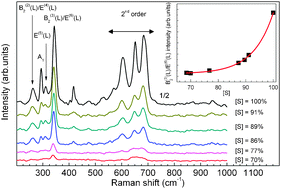Process monitoring of chalcopyrite photovoltaic technologies by Raman spectroscopy: an application to low cost electrodeposition based processes
Abstract
This work describes the use and capabilities of Raman scattering for process monitoring and quality control applications in thin film chalcopyrite photovoltaic technologies. Main vibrational modes in the Raman spectra from the chalcopyrite layers are very sensitive to features related to their crystalline quality, chemical composition and the presence of secondary phases that are relevant for the optoelectronic properties of the absorbers and the efficiency of the solar cells and modules. Measurements performed at different process steps allow for the monitoring of the synthesis process of the chalcopyrite layers, giving information directly related to their processing conditions. These techniques have been successfully applied for the monitoring at on-line and in situ (real time) levels of the electrodeposition processes involved in the fabrication of low cost electrochemical based chalcopyrite solar cells. The results obtained corroborate the strong potential of Raman scattering for these applications, and open interesting perspectives on the development of new real time process control strategies.


 Please wait while we load your content...
Please wait while we load your content...